Remember Kanto? Revisiting Pokémon Blue Version
Step back in time, past the dazzling 3D graphics and online battles, to a simpler era. An era of monochrome screens, chiptune music, and the thrill of catching creatures in tall grass. For many of us, that journey began with a little cartridge for the Nintendo Game Boy: Pokémon Blue Version. It wasn't just a game; it was a phenomenon that defined a generation of handheld gaming.
Alongside its sibling, Pokémon Red, and the later Yellow, Blue kicked off the global obsession with catching, training, and battling pocket monsters. Released internationally after its Japanese debut (where it was based on the updated Pocket Monsters Blue release), it introduced us to the vibrant (or rather, grayscale) world of Kanto and the quest to become a Pokémon Master.
The Dawn of an Era: Kanto Awaits
Landing in Pallet Town, guided by the wise Professor Oak, your adventure immediately pitted you against your rival, Blue (or Gary, depending on your preference!). Choosing your first partner Pokémon – Bulbasaur, Charmander, or Squirtle – felt like a monumental life decision. This wasn't just picking a character; it was selecting a companion for the epic journey ahead.
The goal was clear: defeat eight Gym Leaders, challenge the Elite Four, and complete the Pokédex by capturing all 151 known Pokémon. Simple, yet incredibly deep. The world felt vast, from Viridian Forest to Mt. Moon, Lavender Town to Cinnabar Island. Every route and cave held potential new encounters and secrets.
Catching 'Em All: The Gameplay Experience
Pokémon Blue's gameplay loop was addictive. Explore, battle wild Pokémon, train your team, challenge trainers, defeat Gym Leaders, earn badges, learn HMs to access new areas, and repeat. The turn-based battle system was easy to grasp but offered surprising strategic depth, especially when factoring in type matchups, stats, and status effects.
But the true magic, the revolutionary feature that set Pokémon apart, was the ability to trade and battle with friends using the Game Link Cable. This wasn't a solo experience; it was social. You needed friends with Red Version to complete your Pokédex, fostering a real-world community around the game. Swapping Pokémon felt like a real exchange, building anticipation for that final evolution or that version-exclusive rarity.
Glitches and Legends: The Quirks We Loved
Let's be honest, Pokémon Red and Blue weren't perfect. They were pioneers developed on relatively limited hardware. This led to some memorable glitches that became part of the game's legend:
- MissingNo.: The most famous glitch Pokémon, encountered through specific steps, which could multiply items (like Rare Candies!) but also potentially corrupt your save file. A true digital cryptid.
- The Mew Glitch: A method discovered years after release allowing players to obtain the mythical Mew without a Nintendo event.
- EXP Underflow: A way to instantly level up Pokémon under certain conditions.
These weren't just bugs; they were playground legends, secrets whispered among friends, adding another layer of mystique to the world of Kanto.
Why Blue? Subtle Differences, Big Impact
While largely identical to Red Version, Blue had its own charm. The primary difference lay in the exclusive Pokémon available:
- Blue Exclusives: Sandshrew, Sandslash, Vulpix, Ninetales, Meowth, Persian, Psyduck, Golduck, Mankey, Primeape, Growlithe, Arcanine, Bellsprout, Weepinbell, Victreebel, Magmar, Pinsir.
- Red Exclusives: Ekans, Arbok, Oddish, Gloom, Vileplume, Sirefetch'd, Electabuzz, Magikarp (more common), Scyther, Jynx, Omanyte, Omastar, Kabuto, Kabutops.
Choosing Blue meant committing to a specific roster, influencing your team build and trading priorities. It added a personal touch to your journey.
Beyond the Game Boy: Legacy and Re-releases
The impact of Pokémon Blue (and Red) is undeniable. It launched the biggest media franchise in the world. The core mechanics established here are still the foundation of modern Pokémon games.
If you missed out or want to revisit Kanto, Nintendo has offered official ways to play:
- Nintendo 3DS Virtual Console: Red, Blue, and Yellow were re-released, even simulating the Link Cable for trading and battling.
- Pokémon FireRed and LeafGreen: Excellent remakes for the Game Boy Advance that updated the Kanto experience.
- Pokémon: Let's Go, Pikachu! and Let's Go, Eevee!: Nintendo Switch remakes based on Yellow, offering a different take with Pokémon Go mechanics.
Unofficial methods like emulators also exist, allowing fans to experience the original pixelated adventure on various devices (always remember to own the original game!).
Still Worth Playing Today?
Absolutely. While modern Pokémon games boast incredible graphics and features, there's a unique charm to the simplicity and pioneering spirit of Pokémon Blue Version. The sprites are iconic, the music is unforgettable, and the core adventure remains compelling. It's a perfect snapshot of late 90s retro gaming and the birth of a global phenomenon.
Whether you're chasing nostalgia or curious about where it all began, firing up Pokémon Blue Version is a trip worth taking.
FAQ
Q: What are the main differences between Pokémon Red and Blue? A: The primary difference is the list of exclusive Pokémon you can catch in the wild. To complete the Pokédex, you need to trade with someone who has the other version.
Q: Can I still trade Pokémon between original Red and Blue cartridges? A: Yes, if you have two original Game Boy or Game Boy Color systems and a Game Link Cable. The Nintendo 3DS Virtual Console releases also allowed simulated wireless trading.
Q: What is MissingNo.? A: MissingNo. is a famous glitch Pokémon found in Red and Blue. Encountering it can have various effects, including item duplication, but also potential save data corruption. It's a relic of the original game's code.
Q: Is Pokémon Blue the first Pokémon game? A: In Japan, Pocket Monsters Red and Green were released first, followed by an updated Pocket Monsters Blue. The international Pokémon Red and Blue versions were based on the Japanese Blue code but retained the Pokémon distribution of Red and Green. So, while not the absolute first Japanese release, it's one of the foundational international versions.


